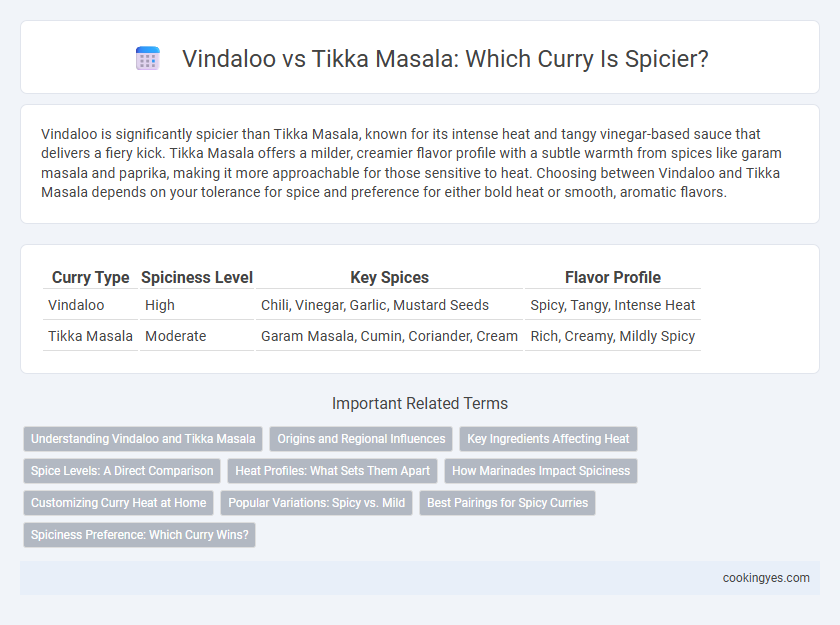Vindaloo is significantly spicier than Tikka Masala, known for its intense heat and tangy vinegar-based sauce that delivers a fiery kick. Tikka Masala offers a milder, creamier flavor profile with a subtle warmth from spices like garam masala and paprika, making it more approachable for those sensitive to heat. Choosing between Vindaloo and Tikka Masala depends on your tolerance for spice and preference for either bold heat or smooth, aromatic flavors.
Table of Comparison
| Curry Type | Spiciness Level | Key Spices | Flavor Profile |
|---|---|---|---|
| Vindaloo | High | Chili, Vinegar, Garlic, Mustard Seeds | Spicy, Tangy, Intense Heat |
| Tikka Masala | Moderate | Garam Masala, Cumin, Coriander, Cream | Rich, Creamy, Mildly Spicy |
Understanding Vindaloo and Tikka Masala
Vindaloo, originating from Goa, is known for its intense heat derived from dried red chilies, vinegar, and a complex blend of spices, making it one of the spiciest Indian curries. Tikka Masala, on the other hand, offers a milder, creamy tomato-based sauce enriched with aromatic spices like garam masala and fenugreek, resulting in a balanced flavor with moderate spiciness. Understanding these differences helps curry enthusiasts choose between Vindaloo's fiery punch and Tikka Masala's rich, flavorful warmth.
Origins and Regional Influences
Vindaloo originates from the Indian state of Goa, influenced by Portuguese cuisine, featuring a tangy vinegar base and intense chili heat, making it one of the spicier curry options. Tikka masala, believed to have roots in Punjabi cuisine and refined in the UK, blends a creamy tomato sauce with moderate spices, offering milder heat compared to Vindaloo. Regional influences dictate Vindaloo's sharp, fiery profile, while Tikka masala balances spices with dairy to create a smooth, less spicy flavor.
Key Ingredients Affecting Heat
Vindaloo curry's spiciness primarily comes from a blend of dried red chilies and black peppercorns, combined with vinegar that enhances its sharp heat profile. In contrast, Tikka Masala features a milder heat level, relying on ground cumin, turmeric, and a touch of cayenne or paprika to provide warmth without overwhelming spice. The key ingredients influencing the heat difference are the use of whole dried chili peppers and vinegar in Vindaloo versus the cream and milder spices in Tikka Masala.
Spice Levels: A Direct Comparison
Vindaloo is renowned for its intense spiciness, often incorporating fiery red chilies and vinegar, resulting in a bold, sharp heat that can overwhelm mild palates. Tikka Masala, while flavorful and rich with creamy tomato-based sauce, generally offers a milder, more balanced spice level suitable for those preferring moderate heat. Comparing spice levels directly, Vindaloo ranks significantly higher on the Scoville scale, making it the preferred choice for spice enthusiasts seeking a robust, fiery curry experience.
Heat Profiles: What Sets Them Apart
Vindaloo curry is known for its intense heat, featuring a bold blend of dried red chilies, vinegar, and garlic that creates a fiery, tangy flavor profile. In contrast, Tikka Masala offers a milder, creamy spiciness with a tomato-based sauce enriched with yogurt and aromatic spices like cumin and coriander. The heat in Vindaloo comes from its high capsaicin content, while Tikka Masala balances warmth with creaminess, appealing to those who prefer a less aggressive spice level.
How Marinades Impact Spiciness
Vindaloo curry typically features a tangy, vinegar-based marinade with fiery red chili peppers, resulting in a sharper and more intense spiciness compared to Tikka Masala. Tikka Masala's marinade emphasizes yogurt and aromatic spices like garam masala, which temper heat while enhancing a creamy, mild spiciness. The acid and chili concentration in Vindaloo marinades amplify capsaicin release, creating a hotter profile than the cumin and coriander-infused, yogurt-based Tikka Masala marinade.
Customizing Curry Heat at Home
Vindaloo traditionally ranks higher in spiciness compared to Chicken Tikka Masala due to its use of dried red chilies and vinegar, offering a tangy, intense heat ideal for spice lovers. Chicken Tikka Masala tends to have a milder, creamier profile with a blend of aromatic spices, making it easier to adjust the heat level with ingredients like yogurt or cream. Customizing curry heat at home can be achieved by controlling chili quantity, choosing between fresh or dried spices, and balancing acidic or dairy components to suit personal spice tolerance.
Popular Variations: Spicy vs. Mild
Vindaloo is known for its intense spiciness, often featuring vinegar, garlic, and fiery red chili peppers, making it one of the hottest curry variations popular in Goan cuisine. Tikka Masala, on the other hand, offers a milder, creamier taste with yogurt, cream, and aromatic spices, appealing to those who prefer less heat but rich flavor. Both curries are celebrated worldwide, but Vindaloo caters to spice lovers, whereas Tikka Masala attracts fans of flavorful yet gentle heat.
Best Pairings for Spicy Curries
Vindaloo, known for its intense heat and tangy vinegar base, pairs exceptionally well with cooling yogurt-based sides like raita or a cucumber salad to balance its fiery spice. Tikka masala, featuring a creamy tomato sauce with moderate spiciness, complements fragrant basmati rice or buttery naan, which help mellow the curry's warmth. Both curries benefit from milder accompaniments that enhance complex flavors while soothing the palate.
Spiciness Preference: Which Curry Wins?
Vindaloo is known for its intense heat, featuring fiery chili peppers and robust vinegar, making it one of the spiciest curries in Indian cuisine. Tikka Masala offers a milder, creamy tomato-based sauce with moderate spices, appealing to those who prefer a balanced flavor without overwhelming heat. For spice enthusiasts seeking maximum heat, Vindaloo wins, while Tikka Masala suits those who favor rich flavors with gentle warmth.
Vindaloo vs Tikka masala for spiciness Infographic

 cookingyes.com
cookingyes.com